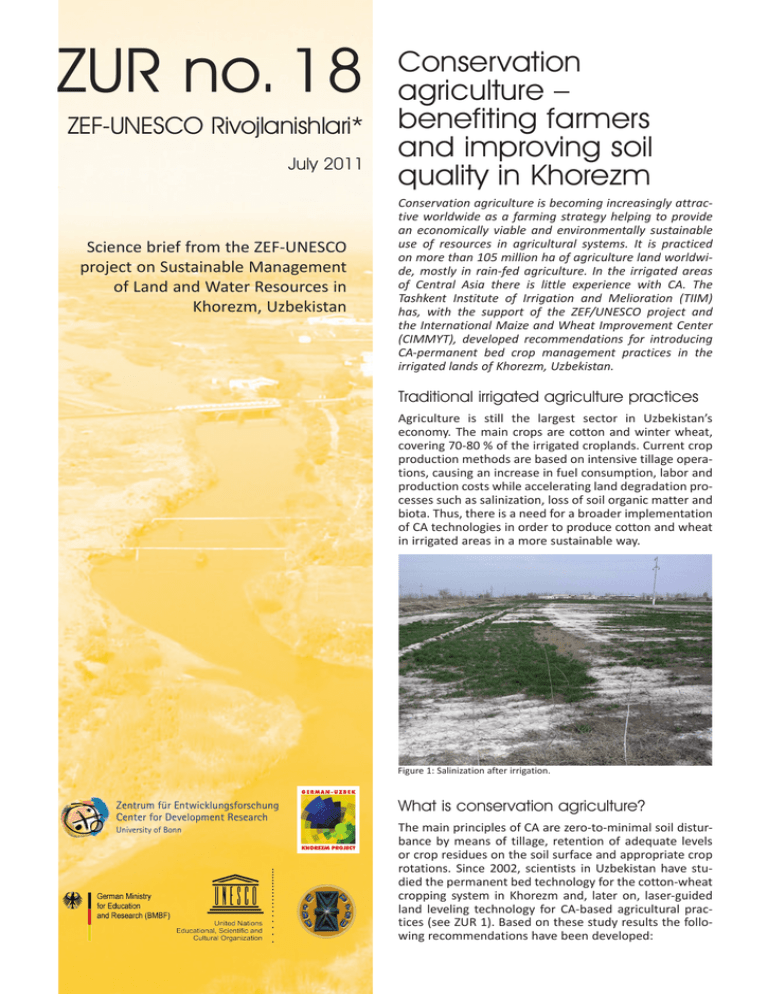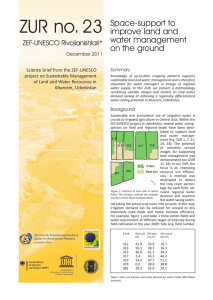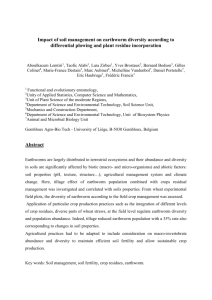ZUR no. 18 Conservation agriculture –
advertisement

ZUR no. 18 ZEF-UNESCO Rivojlanishlari* July 2011 Science brief from the ZEF-UNESCO project on Sustainable Management of Land and Water Resources in Khorezm, Uzbekistan Conservation agriculture – benefiting farmers and improving soil quality in Khorezm Conservation agriculture is becoming increasingly attractive worldwide as a farming strategy helping to provide an economically viable and environmentally sustainable use of resources in agricultural systems. It is practiced on more than 105 million ha of agriculture land worldwide, mostly in rain-fed agriculture. In the irrigated areas of Central Asia there is little experience with CA. The Tashkent Institute of Irrigation and Melioration (TIIM) has, with the support of the ZEF/UNESCO project and the International Maize and Wheat Improvement Center (CIMMYT), developed recommendations for introducing CA-permanent bed crop management practices in the irrigated lands of Khorezm, Uzbekistan. Traditional irrigated agriculture practices Agriculture is still the largest sector in Uzbekistan’s economy. The main crops are cotton and winter wheat, covering 70-80 % of the irrigated croplands. Current crop production methods are based on intensive tillage operations, causing an increase in fuel consumption, labor and production costs while accelerating land degradation processes such as salinization, loss of soil organic matter and biota. Thus, there is a need for a broader implementation of CA technologies in order to produce cotton and wheat in irrigated areas in a more sustainable way. Figure 1: Salinization after irrigation. Zentrum für Entwicklungsforschung Center for Development Research University of Bonn What is conservation agriculture? The main principles of CA are zero-to-minimal soil disturbance by means of tillage, retention of adequate levels or crop residues on the soil surface and appropriate crop rotations. Since 2002, scientists in Uzbekistan have studied the permanent bed technology for the cotton-wheat cropping system in Khorezm and, later on, laser-guided land leveling technology for CA-based agricultural practices (see ZUR 1). Based on these study results the following recommendations have been developed: Recommendations for implementing conservation agriculture Involvement Farmers and stakeholders have to be involved, e.g. through field visits and workshops, to make them test the CA-based crop management practices on their own fields (ZUR 10). Thus, it can be shown that a special sequence of cultivation methods enables a smooth transfer from conventional to CA-based practices. Mind set A major challenge is to convince farmers and stakeholders to change from conventional farming practices depending on extensive tillage, to minimum / no-till seeding practices. This is achieved best through farmer trainings, where the basic principles and benefits of the CA-based system are conveyed. Field preparations Previous intensive tillage operations may have compacted the rooting depth. In such cases, sub-soiling and deep plowing are required to breakdown the hard pan for better crop root development and surface water infiltration. Laser guided land leveling Unevenness of fields obstructs crop germination, water application, soil nutrient utilization and energy resources use, especially during surface irrigation modes. Laserguided land leveling can enhance the soil-water balance, achieve energy savings and improve crop performance (ZUR 1). Mulch producing options Most farmland soils in Uzbekistan have low soil organic matter and contain few plant available nutrients. There are many ways to improve such soils. One of them is the retention of residues from legume crops, cereals (e.g. sorghum), cover crops, and organic manure in addition to mineral fertilizer applications as part of an integrated CA-based system. Deep sub-soiling to destroy soil pan 1st year Laser leveling stage 1st year Permanent bed planting with constant crop cover Multi crop no till seeder Conventional seeders can plant only a single crop under tilled conditions. The CA modified no-till seeders can plant different crops with minimum soil disturbance into crop residue retained land, and simultaneously apply fertilizers. Weed and insect control During the initial 2-3 years, weed management and insect control via herbicides and insecticides require much attention. Later, the accumulated crop residue layer and crop rotations restrict weed germination and insect infestation. Long-term sustainability The implementation of new, not well-known agricultural systems often implies risks to farmers. This can be overcome by starting to implement CA practices on smaller areas– in order to gain experience, also in management and analyzing costs and benefits. Above all, this approach gives farmers a better understanding of CA systems. Next, the new system can easily be applied at a larger scale. Technology Wheat wheat 2005 Cotton 2006 Averaged 2004-2006 2004 (numbers) yield, kg/ha benefit sums/ ha yield kg/ha benefit sums/ ha Soil salinity Organic matter Soil earthworms 1m™ Conventional 5500 395500 3300 278000 0.58 0.74 30 Soil conservation 6000 513000 3000 304000 0.43 0.77 45 +9 +30 -9 +9 -26 +4 +50 Difference, % Findings demonstrate that there are no significant adverse effects from reduced tillage for both cotton and wheat yields (Table). Results from other studies show that yields significantly increase after 5-8 years, and operational costs (savings in fuel, labor and machinery use) can be reduced. In the end CA-based practices lead to higher revenues as compared to conventional tillage practices and to long-term sustainability. IMPRINT Source: http://dswcpunjab.gov.in/contents/Laser_Leveling.htm Appropriate crop rotations Intensive mono-cropping can create problems including weed, disease and pest infestation and fertility decline. Appropriate crop rotations can be help to resolve such problems. Minimum tillage or no tillage Soil tillage and other field operations associated with crop production can reduce up to 45-50% of production costs. Minimum or no-till seeding systems significantly reduce these production cost. Tillage can be used when it is necessary to reshape permanent beds. Authors: Alim Pulatov, Abdulla Karimov, Mehriddin Tursunov, Oybek Egamberdiev, Ken Sayre, John Lamers All the authors work or are affiliated with the ZEF/UNESCO project in Uzbekistan. Editor: Alma van der Veen (ZEF) * ZUR is an abbreviation of ZEF-UNESCO Rivojlanishlari, meaning ZEF-UNESCO Developments. The ZUR science briefs publish scientific project output with policy relevance on a regular basis. Published by the Center for Development Research (ZEF) University of Bonn, Germany Uzbekistan Project Office phone: # 49 228 731917 or 734924 e-mail: khorezm@uni-bonn.de homepage:http://www.khorezm.zef.de/ ZUR no. 18 July 2011





